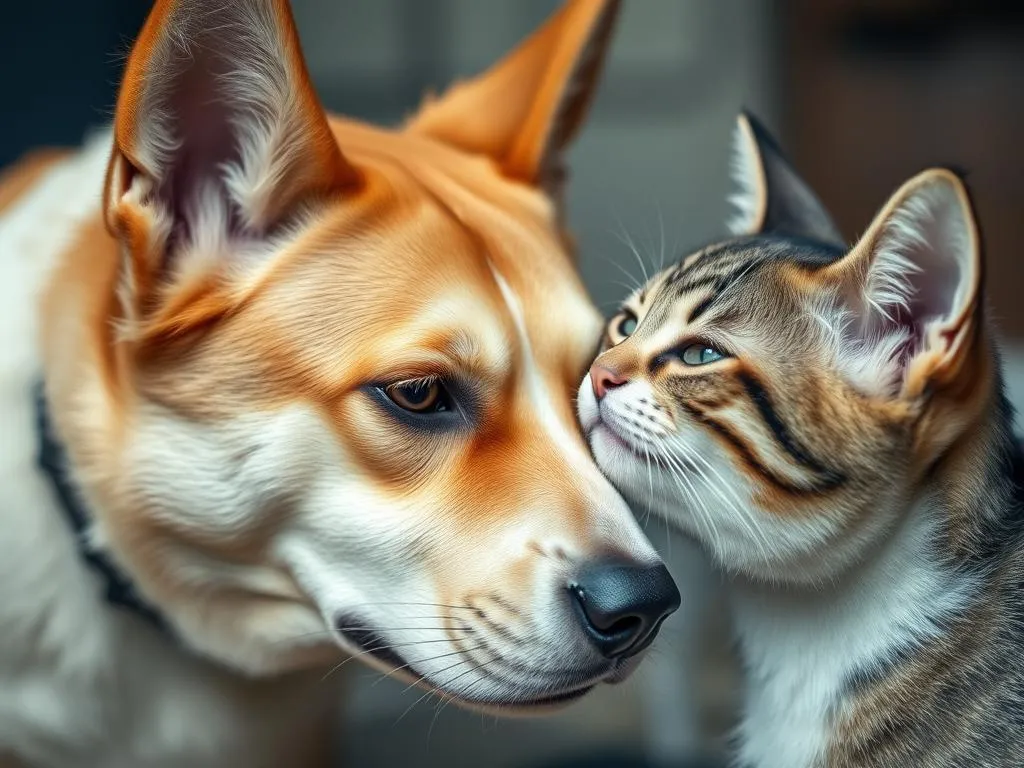
Introduction
In multi-pet households, the dynamics between animals can sometimes feel like a delicate dance. While many pets coexist harmoniously, there are instances where one pet may exhibit bullying behavior towards another. A particularly common scenario is when my cat is bullying my dog. Understanding the underlying reasons for this behavior can not only help pet owners manage their pets more effectively, but it can also foster a more peaceful living environment for everyone involved.
Recognizing the differences in animal behavior is crucial, as it allows pet owners to address issues promptly and effectively. This article aims to provide insights into the causes of bullying behavior, identify the signs that your pets may exhibit, and offer practical solutions to create a more balanced household.
Understanding Animal Behavior
The Nature of Cats and Dogs
Cats and dogs are fundamentally different in their social structures and instinctual behaviors. Dogs are pack animals, thriving on social bonds and hierarchies, while cats are generally more solitary and territorial. This difference can lead to conflicting behaviors, especially when a cat feels threatened or believes it needs to assert dominance over a dog.
Instinctual behaviors also play a significant role. Dogs, as descendants of wolves, have prey drive instincts. They often see smaller animals, including cats, as potential prey. Conversely, cats may display predatory instincts in their playful antics, which can be misinterpreted by dogs as aggression or dominance. This natural instinctual difference is vital to consider when addressing the situation where my cat is bullying my dog.
Common Behaviors of Bullying
Bullying in pets can manifest in various ways. It typically involves one animal intimidating or harassing another. Signs that indicate one pet is bullying another include persistent chasing, blocking pathways, stealing food, or even physical aggression. Recognizing these behaviors early on is crucial to preventing long-term emotional and physical harm to the bullied pet.
Identifying the Signs of Bullying
Behavioral Indicators in Dogs
Dogs that are being bullied may show several signs of stress or anxiety. These can include:
- Hiding: A dog that retreats to a corner or under furniture may be feeling threatened.
- Whining or Barking: Vocalizations can indicate discomfort or fear.
- Changes in Eating or Sleeping Habits: A sudden loss of appetite or disrupted sleeping patterns can signal stress.
If you notice these changes, it may be time to intervene and assess the dynamics between your pets.
Behavioral Indicators in Cats
Cats that are bullying may display aggressive posturing or vocalizations. Common signs include:
- Hissing or Growling: These sounds can indicate territorial aggression.
- Pouncing or Swatting: Overly playful behavior that escalates into aggressive actions can intimidate the dog.
- Body Language: A cat standing tall, with ears back and tail high, may be asserting dominance.
Understanding these behavioral indicators can help pet owners recognize when my cat is bullying my dog and take appropriate action.
Reasons Behind Bullying Behavior
Territoriality
Territorial instincts are strong in both cats and dogs. Cats, being naturally territorial, may feel the need to assert themselves when a dog enters what they perceive as their space. This territorial behavior can lead to bullying, as the cat may chase, hiss, or swat at the dog to establish dominance over its territory.
Jealousy and Competition
Jealousy can be a significant factor in multi-pet households. If one pet feels neglected or believes that another pet is receiving more attention or resources, it may resort to bullying behavior. This is especially common when new pets are introduced to the home, as the resident animal may feel threatened by the newcomer.
Social Hierarchies
The establishment of social hierarchies can also lead to bullying between pets. Cats and dogs will naturally try to establish their rank within the household. If a cat perceives itself as dominant, it may bully the dog to maintain that position. Understanding these dynamics is crucial for pet owners looking to foster better relationships between their animals.
Strategies to Manage Bullying
Creating Safe Spaces
One of the most effective strategies for managing bullying is to create safe spaces for each pet. This allows them to retreat and feel secure when they are feeling threatened. Here are some tips for setting up safe zones:
- Separate Areas: Designate specific areas for each pet where they can eat, sleep, and play without interference from the other.
- Vertical Space for Cats: Cats often feel safer when they have access to high perches or shelves where they can observe their surroundings without being threatened.
By providing individual spaces, you can help mitigate the chances of bullying and allow each pet to feel more secure.
Supervision and Interaction Management
Supervising interactions between pets is crucial, especially during playtime. Techniques for effectively managing these interactions include:
- Controlled Playtime: Schedule regular, supervised play sessions where both pets can interact under your watchful eye. This can help you intervene if bullying behavior begins to surface.
- Positive Reinforcement: Encourage positive behavior by rewarding both pets when they interact without aggression. This helps reinforce good behavior and fosters a sense of cooperation.
Establishing controlled playtime can be beneficial in ensuring that my cat is bullying my dog does not escalate into more serious issues.
Positive Reinforcement
Using positive reinforcement is another effective strategy for managing bullying. Rewarding good behavior with treats and praise can encourage both pets to interact more positively. Training exercises that promote harmony, such as teaching commands like “leave it” or “come,” can also help establish boundaries and reduce bullying behavior.
When to Seek Professional Help
Signs That Professional Help is Needed
While many cases of pet bullying can be managed at home, some situations may require professional intervention. Signs that you may need to seek help include:
- Severe Aggression: If the bullying escalates to the point of serious injury or consistent aggressive behavior.
- Long-Term Stress: If your dog shows signs of chronic stress, such as excessive barking, anxiety, or changes in behavior, it may be time to consult a professional.
Types of Professionals to Consult
When seeking professional help, it’s essential to choose the right type of expert. You may consider:
- Animal Behaviorists: These professionals specialize in understanding animal behavior and can offer tailored strategies to help improve the dynamics between your pets.
- Veterinarians: If health issues are suspected as a cause of bullying behavior, a veterinarian can provide insight and medical advice.
Choosing the right professional can make a significant difference in addressing the issues that arise when my cat is bullying my dog.
Case Studies and Real-Life Examples
Success Stories
Many pet owners have successfully managed bullying behaviors through patience and the right techniques. For example, one family with a cat and dog implemented safe spaces and monitored their interactions. Over time, the pets learned to coexist peacefully, allowing for a more harmonious household.
Lessons Learned from Difficult Cases
However, not all cases are straightforward. Common mistakes pet owners make include ignoring early signs of bullying or failing to provide separate spaces for pets. These oversights can exacerbate the issue, leading to more severe behavioral problems. Learning from these experiences can help other pet owners avoid similar pitfalls.
Conclusion
Understanding the complex dynamics of pet relationships is crucial for creating a peaceful multi-pet environment. By recognizing the signs that my cat is bullying my dog, identifying the underlying reasons for this behavior, and implementing effective management strategies, pet owners can foster a more harmonious living situation.
It’s essential to be proactive in managing interactions between pets and to seek professional help when necessary. With time, patience, and the right approach, it is entirely possible to improve the relationships between your beloved pets.
FAQs
Common Questions About Pet Dynamics
What to do if my cat continues to bully my dog?
If the bullying persists despite your efforts, consider consulting an animal behaviorist for personalized strategies.
How can I tell if my dog is happy despite the bullying?
Look for signs of contentment in your dog, such as wagging tails, relaxed body language, and a willingness to engage in activities they enjoy.
Tips for New Pet Owners
How to introduce a new cat to a resident dog?
Start with gradual introductions, allowing each pet to become accustomed to the other’s scent before face-to-face meetings. Supervise all interactions until you are confident they can coexist peacefully.









